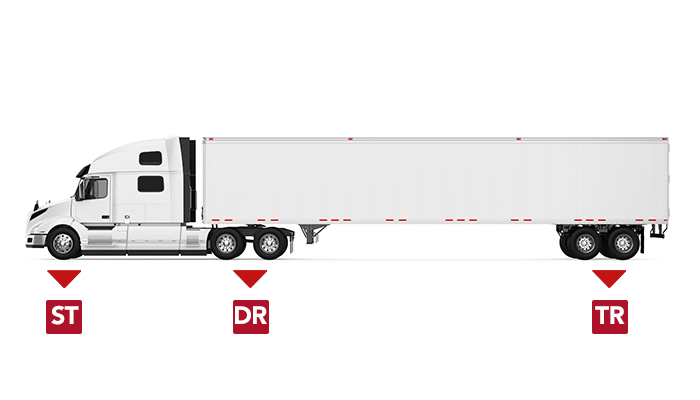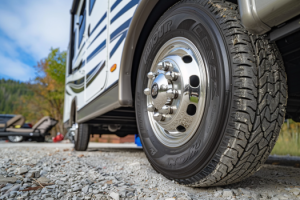Last Updated on March 23, 2024
Exploring the Different Tire Positions and Their Importance
The trucking industry is a crucial component of the U.S. economy. According to the American Trucking Association, commercial trucks are responsible for hauling an estimated 72% of all freight in the country. This amounts to more than 10 billion tons of goods annually.
While the industry has seen steady growth in recent years, it is also highly competitive. As a result, companies are always looking for ways to improve their operations and become more efficient.
When it comes to commercial truck tires, comprehending tire positions is of utmost importance for safety and performance. The correct tire in the right place can significantly affect how your truck handles different loads and road conditions.
In this Truck Tires Guide, we will delve into the various tire positions on commercial trucks, learn about all tire positions of commercial tires, the differences between commercial and regular tires, and understand how to read commercial truck tire markings.
Whether you’re a seasoned truck driver or new to the world of commercial vehicles, this guide will provide valuable insights to help you make informed choices regarding your truck’s tires.
So, what tire positions can you use for a commercial truck? In this article, we will look at the most common truck tire positions and the benefits of each.
Commercial Truck Tire Position Diagram
Let’s look at this diagram before we get into the different tire positions. As you can see, there are three central positions a commercial truck tire can be in – steer, drive, and trailer. Keep the locations of these positions in mind as we break down each one.

The Different Tire Positions on a Truck
Commercial trucks typically have three primary tire positions:
1) Steer Axle Tires
The steer tires are arguably the most critical tires on a commercial truck. These tires shape and guide your handling and provide a smooth ride.
Steer tires are designed to perform their best in the front (steer) axle position to take advantage of the most significant weight distribution. If you use them in another tire position, you may experience decreased performance and uneven wear.
Remember that tires in the front axle position experience the most wear due to the added stress from braking and cornering. You’ll want to select a durable steer tire that can handle various road conditions.
2) Drive Axle Truck Tires
The drive axle is the tire position located right behind the steer axle. These tires are responsible for providing power and traction to the truck. As a result, drive tires need to handle a variety of road surfaces, including asphalt, concrete, and gravel.
Drive axle tires should be selected with durability, traction, and the ability to withstand high torque in mind. While they don’t experience the same type of wear as steering axle tires, they still need to be able to handle a variety of conditions.
3) Trailer Axle Truck Tires
The trailer axle is the position located in the back of the trailer. Trailer tires are responsible for carrying much of the weight of the load. The primary function of a trailer tire is to follow where the trailer is being towed and to support the weight of the shipment.
When selecting trailer tires, you’ll want to consider the maximum weight of the loads you will be hauling and the terrain you will be driving on. Overloading your trailer tires can decrease fuel efficiency, cause premature wear, and potentially a blowout.
If you frequently drive on rough terrain, you should select a designed for on/off-road performance, a tire with cut and chip protection. If you primarily drive on paved roads, choose a tire with SmartWay technology to maximize your fuel-saving and profitability.
All Position Tire
As the name suggests, all position tires are designed to work in any axle position. This means they work in the steer, drive, and trailer tire positions. They are designed to be versatile and combine the features of the other tire position tires. They are not as effective as the others under more extreme conditions but offer good all-around performance.
All position tires allow you to replace a tire in any position in case of failure, lowering your replacement inventory requirements. You will not get as much traction from an all-position tire as a drive tire. You will get a good mix of features in an all-position tire.
All-position tires are a good option for companies needing flexible tire positions. They are also a good choice for trucks that travel long distances, as they can be rotated between different tire positions.
Differences Between Commercial and Regular Tires
Commercial truck tires differ significantly from regular passenger car tires. These differences include:
- Load-Carrying Capacity: Commercial tires are built to handle heavier loads associated with commercial vehicles.
- Tread Patterns: Commercial tires feature unique tread patterns that enhance traction and stability under heavy loads and on various road surfaces.
- Durability: Commercial tires are constructed to withstand high mileage and extended use, making them more robust than regular tires.
- Sidewall Markings: Reading the sidewall markings on commercial truck tires is essential for understanding their specifications, including size, load-carrying capacity, and speed rating.
Regional vs. Long-Haul Application
You’ll also need to decide if you’re using your tires for regional or long-haul applications. Choosing the wrong type of tire can lead to decreased fuel efficiency and premature wear – even when placed in their proper tire positions.
• Regional truck tires are designed for short- to medium-distance trips. They are made to handle various road conditions, frequent starts and stops, and offer excellent traction for winding roads.
• Long-haul truck tires are designed for long-distance trips. They can handle heavier loads and withstand extended periods of use.
Need Help Choosing the Best Tires for Your Commercial Truck?
If you’re looking for the best tires for your commercial truck, Tires Easy Truck is here to help. Our team will work with you to recommend the right tires for your region, driving requirements, and axle position.
Whether you’re looking for steer axle, drive axle, trailer axle tires, or all-position tires, we’ve got you covered. Explore our online selection of commercial truck tires, or contact us today to get started.
Conclusion
Understanding commercial truck tire positions is essential for safety and performance. Whether it’s an all-position tire or a specialized type, knowing the differences between commercial and regular tires helps you make informed choices.
Learning to read the markings on commercial truck tires ensures you select the right tires for your needs. When ready to equip your truck with high-quality tires, choose Tires-Easy-Truck for the best selection and deals.
Explore our wide range of commercial truck tires at Tires-Easy-Truck now and equip your truck with the perfect tires for optimal safety and performance. Don’t compromise on quality; buy from us today!
Ready to roll with more tire insights? Head over to Tire Easy Truck’s website and explore our library of informative articles.
- Top Commercial Truck Tires – Fall 2021 | Unveiling the Best Picks
- The Top 5 Cheap RV Tires & Motorhome Tire Brands for Your Next Adventure
- The Top 5 Best RV Tire Brands on the Market | Quality Picks for Your RV Adventures
FAQs
What are the different tire positions on a truck?
Commercial trucks have various tire positions, including steer, drive, and trailer positions. Each serves a specific function in supporting the vehicle’s weight and handling. Understanding these positions is crucial for proper tire maintenance and replacement.
What is an all-position commercial tire?
An all-position commercial tire is designed to be versatile and can be used in any position on a commercial truck. It offers balanced performance and is suitable for steer, drive, and trailer positions, making it a popular choice for various trucking applications.
What is the difference between commercial tires and regular tires?
Commercial tires are built to withstand heavy loads and high mileage typically associated with commercial vehicles. They have a more robust construction and unique tread patterns than regular passenger car tires, designed for lighter loads and everyday driving.
How do you read a commercial truck tire?
To read a commercial truck tire, look at the sidewall markings. They provide information about the tire’s size, load-carrying capacity, speed rating, and more. Understanding these markings helps you choose the right tires for your specific trucking needs.











